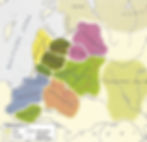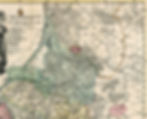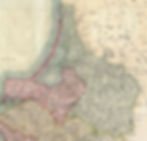When Kaliningrad was Lithuanian
- kapochunas
- May 29, 2022
- 4 min read

Today's Kaliningrad Oblast wikipedia
Lithuania today shares a 297.1 km - 184.6 mile land and sea border with an "oblast," or province, of Russia, named after its administrative center, the city of Kaliningrad. But following the (il)logic of Vlad (The Impaler) Putin, who calls Ukraine a "fake" country, the Kaliningrad enclave has zero historical Russian existence, having been awarded at the July 17 to August 21, 1945 Potsdam Conference to Joseph Stalin and the Soviet Union by US President Harry Truman and UK Prime Minister Clement Attlee, who had replaced Winston Churchill. (Poland was awarded the southern half of East Prussia.) What had been Prussian (with a minority Lithuanian population) for the previous 700+ years, and for countless centuries before that the homeland of Baltic tribes, was suddenly "Russian." You can't get more "fake" than that.
A year before the gift to Stalin, while World War II was still raging, there were 2.6 million civilians in East Prussia. Before the end of the war in May 1945, 2 million of them had been evacuated, leaving 600,000 under control of the Red Army. Aleksandr Solzhenitsyn (Author of "One Day in the Life of Ivan Denisovich") was a Soviet army captain who served in East Prussia in 1945, and who later was arrested for criticizing, in private correspondence with a friend, Stalin and Soviet crimes against East Prussian civilians. He was sentenced to eight years in the gulag for commenting on the numerous murders and rapes committed by Soviet soldiers. He wrote: "You know very well that we've come to Germany to take our revenge" for German atrocities committed in the Soviet Union. The civilian population quickly dropped to less than 200,000. Sound familiar today, with Russian propaganda saying their army has invaded Ukraine to eliminate "Nazis"?
If the Kaliningrad' Oblast is a "fake" Russian area, what is the area's true historical ethnic background? At least 1,500 years ago, the area was populated by Baltic tribes: Old Prussians (Lithuanian: Prūsai), Galindians, Sambians and Yotvingians.

5th Century Baltic Tribes after Marija Gimbutas

12th Century "Old Prussian independent tribes and their borders" wikipedia
Baltic Old Prussians, whom Poles had tried to conquer and convert to Christianity since the 10th century, were finally conquered in the 13th century by the crusading Teutonic Knights, and gradually converted to Christianity. Following Germanization, colonization and assimilation in the following centuries, Germans became the dominant ethnic group, with Balts a significant minority. It was Grand Duke of Lithuania and King of Poland Casimir IV Andrew Jagiellon (Lithuanian: Kazimieras Jogailaitis) who, in the middle of the 15th century, finally ousted the Teutonic Knights from Old Prussian lands.
In the middle of the 18th century, Swiss mapmaker Leonhard Euler, who served in the Russian navy, and later supervised the preparation of the 1745 landmark "Atlas Russicus" while in St. Petersburg, created a map of Prussia (Borussia), published in Berlin, which had the label "Litauen" for the area that would become the Kaliningrad Oblast. By then, the Old Prussian language had become extinct, supplanted by Lithuanian.

1753 Leonhard Euler (mapmaker): "BORUSSIA REGIA et DUCALIS..," Berlin, from his "Geographischer Atlas." Besides the "LITAUEN" label, note the two Prussian-owned (1691 - 1793) areas of the Grand Duchy of Lithuania colored reddish-purple east of the Memel - Klaipėda region: "Herrschaft Tauroggen" (Tauragė) and "Herrschaft Serrey" (Seirijai): compensation to the Kingdom of Prussia for the marriage of Margrave Ludwig of Brandenburg to Lithuanian Princess Ludwika Karolina Radziwiłł (a descendant of the Gediminids and Jagiellons). www.davidrumsey.com
In 1808, British mapmaker John Cary labeled the eastern part of Prussia, as well as the Memel/Klaipeda area, "Little Lithuania." Lithuanians would come to call it Mažoji Lietuva, Lithuania Minor, a key area in the late 19th century in the smuggling of books and magazines in Lithuanian using Latin characters across the border into Lithuanian areas controlled by the Russian Empire.

1808 John Cary (mapmaker): Detail, "A New Map of the Kingdom of Prussia..," London, from "Cary's New Universal Atlas." Geographicus via wikimedia
The Prussian census of 1890 counted 121,345 Lithuanian speakers.

1911 V. Verbickas (Lithuanian archaeologist/engineer/publisher): "Lietuvos žemelapis su etnografijos siena" (Map of Lithuania with ethnographic borders), published in St. Petersburg by the Il'in firm, and in Kaunas by the company "Lietuvos ūkininko" (Lithuanian Farmer). From The Wroblewski Library of the Lithuanian Academy of Sciences: elibrary.mab.lt/
After World War II Stalin insisted that Russia be granted at least half of East Prussia. The Red Army made no distinction between Prussian Lithuanians and ethnic Germans. Some Prussian Lithuanians who had fled west ahead of the advancing Russian army tried to return to their East Prussian homes, but they were discriminated against and denied food rations by the Soviets. According to some historians, Stalin created the oblast separate from the Lithuanian SSR because it further separated the Baltic states from the West. Others think that the reason was that the region was far too strategic for the USSR to leave in the hands of an SSR other than the Russian one. Names of the cities, towns, rivers and other geographical features were changed to Russian names.
In the 1950s, Nikita Khrushchev offered the Kaliningrad Oblast to the Lithuanian SSR, but Antanas Sniečkus (First Secretary of the Communist Party of Lithuania from August 1940 to January 1974) refused to annex the territory because it would add at least a million ethnic Russians to Lithuania, becoming a quarter of the population. The oblast's demographics in 1959 vs. 2010:
1959 2010
Russians 473,861 (77.6%) 772,534 (86.4%)
Ukrainians 35,717 (5.8%) 32,771 (3.7%)
Belarusians 57,178 (9.4%) 32,497 (3.6%)
Lithuanians 21,262 (3.5%) 9,769 (1.1%)
In April 2022, a close ally of Vladimir Putin warned NATO that if Sweden and Finland joined the U.S.-led military alliance then Russia would have to bolster its defenses in the region, including by deploying nuclear weapons. Russia already has nuclear weapons in the Baltic region, replied Lithuanian Defense Minister Arvydas Anusauskas. "The current Russian threats look quite strange, when we know that, even without the present security situation, they keep the weapon 100 km [62 miles] from Lithuania's border," the minister said. "Nuclear weapons have always been kept in Kaliningrad [and] the international community, the countries in the region, are perfectly aware of this. They use it as a threat," he said.

